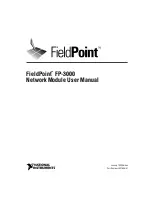
Chapter 8: STP and RSTP
114
Overview
The performance of a Ethernet network can be negatively impacted by the
formation of a data loop in the network topology. A data loop exists when
two or more nodes on a network can transmit data to each other over
more than one data path. The problem that data loops pose is that data
packets can become caught in repeating cycles, referred to as broadcast
storms, that needlessly consume network bandwidth and can significantly
reduce network performance.
STP and RSTP prevent data loops from forming by ensuring that only one
path exists between the end nodes in your network. Where multiple paths
exist, these protocols place the extra paths in a standby or blocking mode,
leaving only one main active path.
In addition, STP and RSTP can activate a redundant path if the main path
goes down. So not only do these protocols guard against multiple links
between segments and the risk of broadcast storms, but they can also
maintain network connectivity by activating a backup redundant path in
case a main link fails.
Where the two protocols differ is in the time each takes to complete the
process referred to as
convergence
. When a change is made to the
network topology, such as the addition of a new bridge, a spanning tree
protocol must determine whether there are redundant paths that must be
blocked to prevent data loops, or activated to maintain communications
between the various network segments. This is the process of
convergence.
With STP, convergence can take up to a minute or more to complete in a
large network. This can result in the loss of communication between
various parts of the network during the convergence process, and the
subsequent lost of data packets.
RSTP is much faster. It can complete a convergence in seconds, and so
greatly diminish the possible impact the process can have on your
network. The STP implementation in the AT-S109 Version 1.1.0
Management software complies with the IEEE 802.1d standard.
Only one spanning tree at a time can be active on the switch. The default
protocol is RSTP. The RSTP implementation complies with the IEEE
802.1w standard.
The following subsections provide a basic overview on how STP and
RSTP operate and define the different parameters that you can adjust.
Содержание AT-GS950/24
Страница 12: ...Figures 12 ...
Страница 14: ...List of Tables 14 ...
Страница 18: ...Preface 18 ...
Страница 29: ...AT GS950 24 Web Interface User Guide 29 Note You can add up to 10 IP address to the IP Access List table ...
Страница 60: ...Chapter 2 Basic Switch Configuration 60 ...
Страница 68: ...Chapter 3 Port Configuration 68 ...
Страница 74: ...Chapter 4 Port Mirroring 74 ...
Страница 94: ...Chapter 5 Virtual LANs 94 ...
Страница 102: ...Chapter 6 GVRP 102 ...
Страница 132: ...Chapter 8 STP and RSTP 132 ...
Страница 146: ...Chapter 9 Multiple Spanning Tree Protocol 146 ...
Страница 156: ...Chapter 10 Static Port Trunking 156 ...
Страница 178: ...Chapter 12 Quality of Service CoS 178 ...
Страница 206: ...Chapter 13 Access Control Configuration 206 ...
Страница 226: ...Chapter 15 MAC Address Table 226 ...
Страница 238: ...Chapter 16 DHCP Snooping 238 ...
Страница 244: ...Chapter 17 IGMP Snooping 244 ...
Страница 288: ...Chapter 21 Simple Network Management Protocol SNMPv3 288 ...
Страница 300: ...Chapter 22 RMON 300 ...
Страница 322: ...Chapter 24 Management Software Updates 322 ...
Страница 348: ...Appendix A MSTP Overview 348 ...
Страница 366: ...Appendix A AT GS950 24 Default Parameters 366 ...
















































